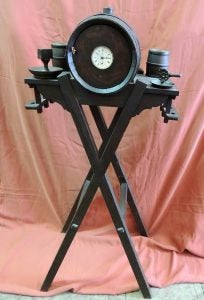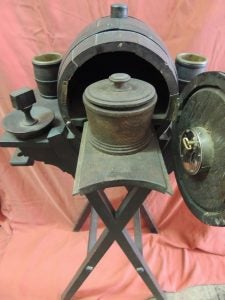Personal Effects: Humidor with timepiece worth a pretty penny just as it is
Published 5:41 pm Friday, February 22, 2019
Question: Jerry, it appears that I have an unusual humidor cabinet. I bought it at a small antique store in the Georgia mountains several years ago. Its design was supposedly created for an old sea captain who wanted his 1890 Westminster pocket watch (runs 30 hours) to be the centerpiece for the door of the “whiskey keg.” The watch still runs perfectly. What can you tell me about humidor cabinets? Should I have this piece restored?
 Answer: Boy, this piece hits all the high spots and rings all the bells. It is an unusual piece. You are indeed correct that it is a humidor for all a gentleman’s smoking needs.
Answer: Boy, this piece hits all the high spots and rings all the bells. It is an unusual piece. You are indeed correct that it is a humidor for all a gentleman’s smoking needs.
Humidors have been around for centuries. I assume that in its earliest form, a damp sponge on a dish, locked inside a box, helped to maintain fresh tobacco. Humidors help to regulate the moisture content of tobacco. Too little or too much humidity results in an unpleasant smoking experience. Ask any cigar buff about this.
Manufactured tobacco humidors hit their highpoint in the 1870s or so.
Let’s go over all the features of this piece. There is a guillotine type cigar cutter, a small match box holder, one container for ashes, another container for cigarettes, the barrel has a pull out tray with a small container for pipe tobacco with storage for cigars underneath, pipe racks on both sides and it has a clock on the front of the barrel. Just about everything that a gent would need. All of this is mounted in a cool cross stand.
 I’m not sure about the sea captain aspects. I have to concur that it’s likely a legend. Here’s the fact that I can share with you. Your humidor is arts and crafts style, as evidenced from the gorgeous dark oak finish and the mortise-and-tenon joints on the base and on top. It’s machine-made. That’s going to date it to the 1890s to the early 1900s.
I’m not sure about the sea captain aspects. I have to concur that it’s likely a legend. Here’s the fact that I can share with you. Your humidor is arts and crafts style, as evidenced from the gorgeous dark oak finish and the mortise-and-tenon joints on the base and on top. It’s machine-made. That’s going to date it to the 1890s to the early 1900s.
I get an American feel about it, as opposed to an English piece that would just be more polished and finished. I think that the clock, which by the way is a Waterbury clock, and thanks to your photos, has a last patent date of 1894, has always been in this piece. I see no evidence that it’s been added at a later date.
I closely looked at the photos, but found no evidence of any type of maker’s mark or stamp. This leads me to think that it’s not one of the important arts and crafts makers, but that can’t be ruled out until I get some concrete evidence on who actually made it.
I have to say that I’ve not seen the form before. Sadly, I can’t find any reference in anything in my library or the internet. I’ll find something though. Like I said earlier, it rings all the bells. Not only is it a smoking humidor and will appeal to tobacco collectors, it will also be loved by bourbon and whiskey aficionados. In case you didn’t know it, bourbon is white hot now in the collecting world. Naturally, cigars go with bourbon. Plus it’s different, the watch/clock works and it’s very manly in its feel. All of these things add to its value.
Restore it?! If you had refinished it or even polished the metals it would have been RUINED.
Collectors are so picky about finishes. Today, with the changes in the market, arts and crafts styles aren’t bringing the big bucks the way it was in the late 1990s. However, I think that this piece has so many many fine attributes, that it’s going to push beyond average tastes and trends. I expect that at a fine antiques show, and barring that it’s by a well known maker, that it would be priced at about $375. Thanks for sharing it. It’s a super piece.






